-

人教版高中历史必修2开辟新航路说课稿3篇
一、说教材《开辟新航路》是高中《历史·必修二》第5课的内容。从三个方面向学生介绍了欧洲人开辟新航路的历史:即新航路开辟的原因和条件、新航路开辟经过以及影响。前4课内容介绍了古代中国经济的基本结构与特点,从第5课开始学习资本主义世界市场的形成和发展。本课内容相当重要,上承古代中国,下启近代世界。新航路的开辟,打破了世界相对隔绝的状态,世界真正开始融合为一个整体。从此,以西欧为中心的世界市场的雏形开始出现。随后的殖民扩张,世界市场拓展;第一次工业革命,世界市场基本形成;第二次工业革命,世界市场发展。二、说目标1、课程标准概述迪亚士、哥伦布开辟新航路的史实,认识地理大发现对世界市场形成的意义。2、三维目标①知识与能力:掌握新航路开辟的原因、经过、影响。②过程与方法:引导学生分析原因及影响,培养学生分析和归纳问题的能力。③情感态度与价值观:A、通过对新航路开辟过程的学习,使学生感受和学习探险家们勇于进取的开拓精神。B、通过学习新航路开辟的影响,使学生认识新航路开辟促进了人类社会的整体发展。

人教版高中英语必修2Computers说课稿3篇
一. 教材分析1. 本单元的中心话题是“计算机(Computers)”,内容涉及计算机的发展历史,计算机的应用等。本节课是该单元的第一课时,我将Warming up, Pre-reading and Comprehending这四部分整合为一节精读课。其中。Reading部分是题为WHO AM I?的文章,以第一人称的拟人手法介绍了计算机发长演变的历史和计算机在各个领域的应用,其主旨是表达计算机的发展变化之快以及在生活中用途之广。而Warming up部分以图片的形式展现了计算机的发展历程;Pre-reading中的问题和排序分别是为了预测语篇的内容和测试学生对计算机历史了解的情况;Comprehending则通过各项练习训练学生的阅读技能,从而加深对文章的理解。可见这几部分是一个有机的整体。2. 教学目标:1) 语言目标:重点词汇及短语:abacus, calculate, calculator, PC, laptop, PDA, robot, analytical, technological, universal, mathematical, artificial, intelligent, network, explore, in common, as a result.重点句子:a. My real father was Alan Turing, who in 1963 wrote a book to describe how computers could be made to work, and build a “universal machine” to solve any mathematical problem.

人教版高中英语必修4A taste of English Humor说课稿3篇
Then I would ask them to think of a funny English or Chinese and tell it to partners. While telling stories, they can use expressions and some acting to help make the story funny. 5 minutes would be given to do this.Those stories they told there will be the material for their writing. Soletting them tell it at first is helpful. And they can make a difference between telling a funny story and writing it down. Generally speaking, it is difficult forstudents to write well because they don’t know what to write and how to write. Asking them to tell their own stories at first can help them come up with what to write.After their telling, I would invite someone to share his/her story with all of us and I would write it down on the blackboard.This example story would be used as a sample to illustrate the format of funny story. Different from a story from teacher or textbook, a story from students can obviously become a interesting material to draw students’ attention.Then I would ask the whole class to put this story into several parts. It might be a little bit difficult for them. So I would ask them to find out whether all the sentences are necessary. After delete some sentences, there are 6 sentences left behind. Then they can easily put them into three parts. After interaction with students, I would teach them the right terms for each part and conclude the format of funny story.This step is the key and difficult point in my lesson. So I mainly usetask-based teaching method in this part and the task for students was divided into several stages. With the separated difficult level, students can find there are usually three parts in writing. They can also learn to write without the unnecessary parts in the process of analyzing. And then I wouldn’t rush to tell them the right terms to them directly. Instead, I would ask them to name them by their own. A confused mind is better for acquiring knowledge.While-writing:Then I would give students 7 minutes to write down this story, without other requirements.With all the preparations in pre-writing, students’ difficulties were cleared. So it would be much easier for them to write down the story within 7 minutes. There are no other requirements because students’ first writing is actually a drafting. It would be revise and edit several times later. Writing, as a skill

人教版高中英语必修4Theme parks说课稿3篇
The oldest and the most popular park in the worldenjoy the exciting activities thereget close to the life-size cartoon characters like Mickey Mouse and Donald Duck Step 3 Pre-reading1.What do you suppose a theme park is ?2.What do you think you can see in a theme park?(1.It is a kind of amusement park which has a certain theme – that the whole park is based on. 2.buildings, castles, statues, rare animals and birds, and so on.) Step 4 Reading ----- Theme Parks –---- Fun and More Than Fun1.Predict : Read the title and the pictures on P. 34 and PredictWhat is the meaning of the title “Theme Park – Fun and more than fun”?(The title means that theme parks are fun to visit, but that they can also be educational and can offer useful information.)2.Skimming Fast read and answer:What activities can we take in a theme park?Amusement park: Bumper car Merry-go-round slide bungee jumping Free-fall rides Horror films Pirate ship Ferris wheel roller coaster3.Scanning Read again and you will find various theme parks are mentioned in the passage . Then what are they ?Theme parks: Sports theme park History theme park Culture theme park Marine or Ocean theme Park Future park Science theme park Disneyland4.Careful reading and find the main idea of each paragraph:THEME PARKS---- entertaining/ educationalPara.1 Traditional parks are places to go for relaxation and to have time away from our busy lives.Para.2 Theme parks are different They’re large and full of things to do, see and buy.Para.3 Theme parks are built around a single idea or theme. One example is a sports park.Para.4 Another kind of theme park is historical more and cultural and can be educational.Para.5 Disneylandwas the first theme park. It is based on the fantasy life and characters of Disney’s films.Para.6 Some examples of educational theme parks include sea world parks and science parks.

人教版高中英语必修4Working The Land说课稿3篇
Knowledge objectives:(1) to make Ss grasp the usage of words, expressions and sentence structures: statistics, struggle, thanks to, rid of, some patterns for persuasion, the “ing” form as subject and object;(2)to use learnt knowledge to persuade sb.Ability objectives:(1) to develop Ss’ reading skills(skimming, scanning, word guessing);(2) to improve Ss’ speaking, communicating and cooperating skills.Emotional objectives:to make Ss know the contribution of Yuan,and learn his spirit and his simple life time.Teaching important and difficult points:(1) some words, expressions and sentence structures mentioned above;(2)the content of the text;(3)training their reading and speaking skills.Teaching methods: CLT, TBLT,QT.Learning strategies: CLS, QLS, TBLS.Teaching procedures:Step 1 lead-in: (1) teacher plays a piece of recent news from CCTV about the harvest of the super hybrid rice, and ask students whether they know Yuan or not, and talk about him and his contribution.(2)Brain storm: let Ss describe Yuan in their minds including his appearance, his living condition and so on.Step 2 fast reading tasks:(1)teacher introduces Yuan and super hybrid rice(2)make Ss read the text as fast as possible with questions. Such as: what’s the general ideaof this passage? What’s Yuan’ dream? (skimming and scanning skill)Step 3 intensive reading tasks(1)let Ss read the text silently, find topic sentence of each paragraph and draw the difficult sentences and the knowledge what they don’t understand.(words guessing)(2)teacher and Ss talk about the important words, expressions and sentences together, and ask Ss to retell the content of the text.(summarizing and paraphrasing)(3)teacher summarize this part.(4) read again following the courseware.
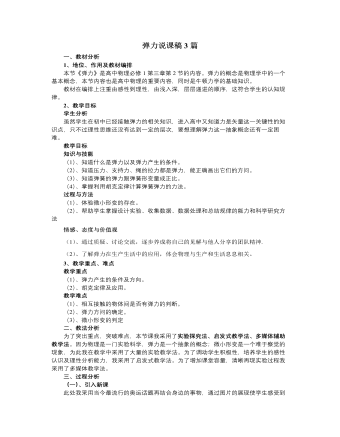
人教版新课标高中物理必修1弹力说课稿3篇
基于以上分析,为使本堂课围绕重点、突破难点,同时让学生在课堂教学中能力得到提高,我设计如下教学过程。(一)创设情景认识形变由同学们已有的形变知识入手,引入新课。教师演示:①弹簧的压缩形变;②弹簧的拉伸形变③视频播放:竹竿形变、钢丝的扭转形变。得出形变的概念及各类形变。[设计意图:我从生活情景中引入新课,是为了激发学生的好奇心,为学生学习重点和难点内容作铺垫。]设问:摩天大楼在风的吹拂下会不会摆动,发生形变吗?演示微小形变放大实验:由于这种形变不容易观察,会使学生产生疑问:到底有没有发生形变?解决的办法是微小形变的演示实验。为什么光点会往下移?让学生带着问题思考后得出结论:是由于桌面发生了形变,但是形变不明显。为后面解决压力和支持力都是弹力做好铺垫。[设计意图:使学生知道“放大”是一种科学探究的方法。]
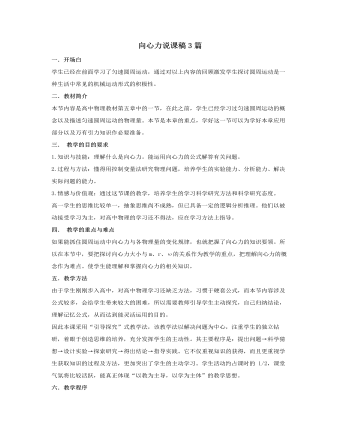
人教版新课标高中物理必修2向心力说课稿3篇
通过这个示例呢,我们可以得到解决向心力问题的一般的步骤,确定对象,找出轨迹,找出圆心,然后进行受力分析,让同学们参考这样的步骤,逐步的解决圆周运动的问题,对于变速圆周运动,我通过链球运动进行引入,这里是一个链球运动的视频,在同学们观看视频之前,我给同学们提出问题,链球收到绳子的拉力,做的是匀速圆周运动吗? 然后再课堂上我们再做一个小实验, 我们可以通过改变拉线的方式来调节小球的速度大小吗? 那么对小球,做加速圆周运动,进行受力分析,我们可以看到,小球做加速运动时,他所受到的力,并不是严格通过轨迹的圆心,在进行分析的时候,特别强调,小桶所受力的切线方向分力,和法线方向分力,切线方向分力,改变小球运动速度大小,法线方向分力,改变了小球运动的方向,法线方向的分力,在这里就是向心力,产生了向心加速度,通过这样一个例子进行分析,同学们是比较容易理解的,

大班交通安全教案
活动目标: 1、让幼儿了解一些基本的道路安全知识。 2、在观察讨论的活动中掌握遵守交通规则的具体行为方式,提高交通安全意识。 3、在游戏活动中体验交通规则的重要性,养成自觉遵守交通规则的好习惯,提高自我安全防护能力。 活动准备: 幼儿交通安全宣传片《上学路上》;交通安全标志图片,信号灯卡片;布置场地:路口、人行横道。
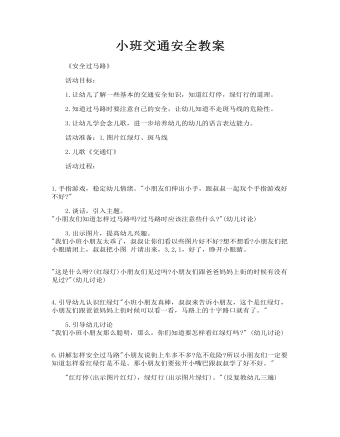
小班交通安全教案(精品版)
1.手指游戏,稳定幼儿情绪。"小朋友们伸出小手,跟叔叔一起玩个手指游戏好不好?" 2.谈话,引入主题。 "小朋友们知道怎样过马路吗?过马路时应该注意些什么?"(幼儿讨论) 3.出示图片,提高幼儿兴趣。 "我们小班小朋友太乖了,叔叔让你们看以些图片好不好?想不想看?小朋友们把小眼睛闭上,叔叔把小图 片请出来,3,2,1,好了,睁开小眼睛。 "这是什么呀?(红绿灯)小朋友们见过吗?小朋友们跟爸爸妈妈上街的时候有没有见过?"(幼儿讨论)
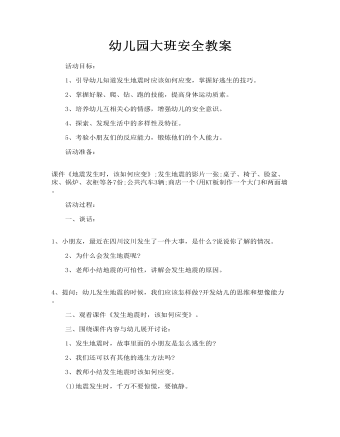
幼儿园大班安全教案
一、谈话: 1、小朋友,最近在四川汶川发生了一件大事,是什么?说说你了解的情况。 2、为什么会发生地震呢? 3、老师小结地震的可怕性,讲解会发生地震的原因。 4、提问:幼儿发生地震的时候,我们应该怎样做?开发幼儿的思维和想像能力。

大班健康:小小安全员教案
2、 知道火灾给我们的生活带来的危害。3、 丰富幼儿的防火知识。知道简单自救技能。活动准备:拼图图片三张,易燃物品标记,火警标记,严禁烟火标记个一。小小安全员标记人手一个。食物展示仪,图片。
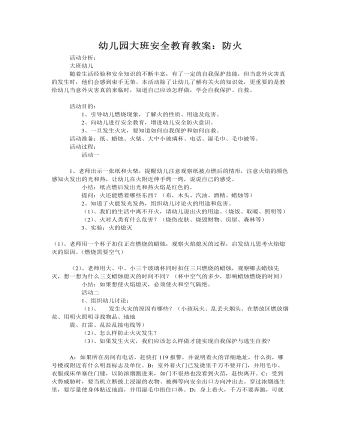
大班安全教案:防火
活动目的: 1、引导幼儿燃烧现象,了解火的性质、用途及危害。 2、向幼儿进行安全教育,增进幼儿安全防火意识。 3、一旦发生火灾,要知道如何自我保护和如何自救。 活动准备:纸、蜡烛、火柴、大中小玻璃杯、电话、湿毛巾、毛巾被等。
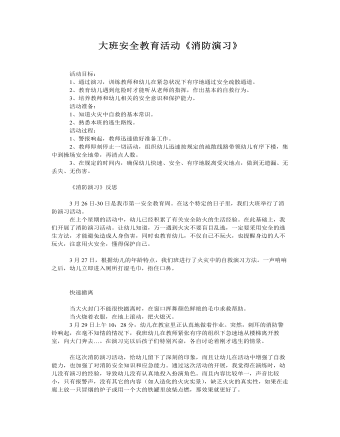
大班安全教案:消防演习
2、教育幼儿遇到危险时才能听从老师的指挥,作出基本的自救行为。 3、培养教师和幼儿相关的安全意识和保护能力。 活动准备: 1、知道火灾中自救的基本常识。 2、熟悉本班的逃生路线。 活动过程: 1、警报响起,教师迅速做好准备工作。 2、教师即刻停止一切活动,组织幼儿迅速按规定的疏散线路带领幼儿有序下楼,集中到操场安全地带,再清点人数。 3、在规定的时间内,确保幼儿快速、安全、有序地脱离受灾地点,做到无遗漏、无丢失、无伤害。
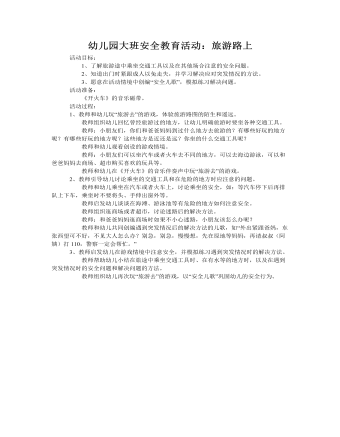
大班安全教案:旅游路上
2、知道出门时紧跟成人以免走失,并学习解决应对突发情况的方法。 3、愿意在活动情境中创编“安全儿歌”,模拟练习解决问题。 活动准备: 《开火车》的音乐磁带。 活动过程: 1、教师和幼儿玩“旅游去”的游戏,体验旅游路图的陌生和遥远。 教师组织幼儿回忆曾经旅游过的地方,让幼儿明确旅游时要坐各种交通工具。 教师:小朋友们,你们和爸爸妈妈到过什么地方去旅游的?有哪些好玩的地方呢?有哪些好玩的地方呢?这些地方是近还是远?你坐的什么交通工具呢? 教师和幼儿观看创设的游戏情境。 教师:小朋友们可以坐汽车或者火车去不同的地方,可以去海边游泳,可以和爸爸妈妈去商场、超市购买喜欢的玩具等。 教师和幼儿在《开火车》的音乐伴奏声中玩“旅游去”的游戏。
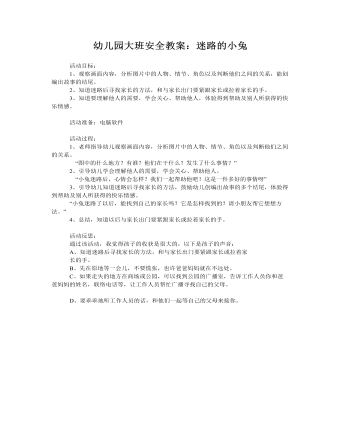
大班安全教案:迷路的小兔
2、知道迷路后寻找家长的方法,和与家长出门要紧跟家长或拉着家长的手。 3、知道要理解他人的需要,学会关心、帮助他人,体验得到帮助及别人所获得的快乐情感。 活动准备:电脑软件 活动过程: 1、老师指导幼儿观察画面内容,分析图片中的人物、情节、角色以及判断他们之间的关系。 “图中的什么地方?有谁?他们在干什么?发生了什么事情?”

大班安全教案:紧急撤离
活动准备 1、幼儿、家长和教师共同收集报刊、杂志、电视报道中有关紧急撤离的事例或图片。 2、班级紧急撤离图。 活动过程 1. 组织幼儿观看录像或图片,让幼儿感知遇到突发事件给人们带来的危害(煤气泄漏;火灾等)。 提问:“如果遇到突发事情时怎么办?”引导幼儿说说自己的见识和感受。知道遇到突发事件不要慌,有秩序地撤离可以避免危害的发生。 2。出示班级撤离图,带幼儿观察并找出班级在紧急情况下撤离的路径和位置。 引导幼儿讨论;为什么撤离时要走图中标注的路径?使幼儿了解图中标注的撤离路径是离户外安全地带最近的一条通道。
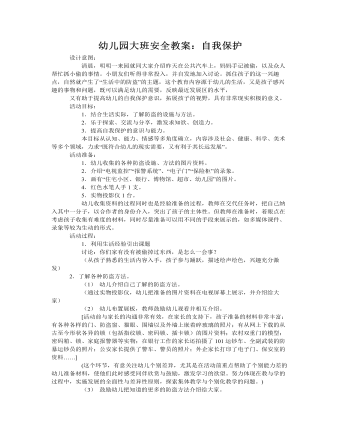
大班安全教案:自我保护
活动目标: 1.结合生活实际,了解防盗的设施与方法。 2.乐于探索、交流与分享,激发求知欲、创造力。 3.提高自我保护的意识与能力。 本目标从认知、能力、情感等多角度确立,内容涉及社会、健康、科学、美术等多个领域,力求“既符合幼儿的现实需要,又有利于其长远发展”。 活动准备: 1.幼儿收集的各种防盗设施、方法的图片资料。 2.介绍“电视监控”“报警系统”、“电子门”“保险柜”的录象。 3.画有“住宅小区、银行、博物馆、超市、幼儿园”的图片。 4.红色水笔人手1支。

大班安全教案:不乱吃东西
2、每到周一时,有的孩子会经常性的闹肚子。 3、在日常生活中,幼儿很喜欢把一些小硬片、碎纸等东西放入口中。 4、进餐时,有的幼儿爱说话,疯闹,嘴里含着饭就去玩了。 5、有的幼儿不生病也硬缠着父母带药到幼儿园。 6、幼儿的自我保护意识差。 [活动目标] 1、通过真实的案例让幼儿懂得随便乱吃东西的危害性。 2、引导幼儿乐于探索、交流与分享,激发幼儿的想象力。 3、提高自我保护的意识及应对安全事件的能力。 [活动准备] 真实案例《卡在喉咙里的五角星》;课件《进餐时》、《肚子为什么疼》;情景表演《好吃的鱼》; 图片: 1、老鼠、苍蝇叮咬过的食物。 2、过期的食物。 3、腐烂变质的食物。 4、假冒、劣质的食物。 5、没洗干净的;每组一小筐(内有图片如:幼儿一边走一边喝水;吃饭时在说笑;吃大量的雪糕;把铅笔放入口中等)
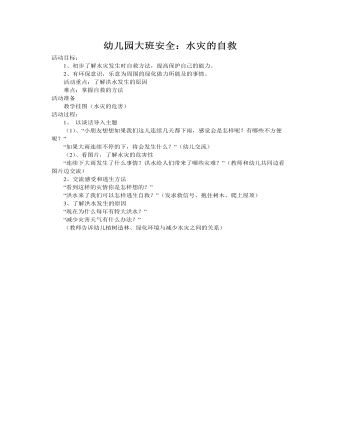
大班安全教案:水灾的自救
2、有环保意识,乐意为周围的绿化做力所能及的事情。 活动重点:了解洪水发生的原因 难点:掌握自救的方法活动准备 教学挂图(水灾的危害)活动过程:1、 以谈话导入主题 (1)、“小朋友想想如果我们这儿连续几天都下雨,感觉会是怎样呢?有哪些不方便呢?”“如果大雨连续不停的下,将会发生什么?”(幼儿交流)

大班安全教案:小心陌生人
一、观看录像,组织讨论。 (1)回顾童话内容 师:“小朋友们,你们看过白雪公主的故事吗?(幼:看过……) 师概括故事:白雪公主非常的善良、非常的美丽,可是故事里有个狠毒的皇后,她因为嫉妒白雪公主的美丽而多次设法害白雪公主,幸好每一次都被爱帮助人的小矮人救活了。 师:好,现在请小朋友们来欣赏、回忆一段小影片吧。(幼儿的积极性被调动) (2)欣赏故事,学习生词“陌生人”。 1)播放的内容是白雪公主中哪段故事?(幼:白雪公主被毒死的小片段) 2)来敲门的人是谁?(揭示:皇后扮演的老巫婆) 3)白雪公主为什么会昏倒?(因为她吃了有毒的苹果,那是“老巫婆”骗她的,是要毒害她的)。 4)假如现在老师带你们去见白雪公主,你会对她说什么话?(引导幼儿大胆说出自己心中的想法)。 教师小结:小朋友们刚才说的都非常好,一个人独自在家时不能随便开门,不能随便相信不认识的人的话,不认识的人叫“陌生人”,对“陌生人”要小心警惕。